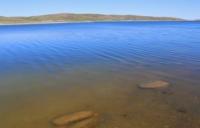You are here
Birzhankol lake in Bayanaul.

Cultural walking excursion in Astana.
“I look: as in a mirror, reflected
In the lakes of your heavens depth
In the bright ripples they swim, resting,
And the rose of dawn, and near the moon.
Here is a cloud on your cliff
And also looks into the lake reach"
Dikhan Abilev, (Translation by D. Priymak).
last minute tour to Pavlodar.
Birzhankol Lake is located 24 kilometers northwest of the village of Bayanaul, north of the tract Zhamanaul. Catchment area: total 4.6 sq. Km. without the average area of the lake - 3.9 sq. km. The lake is closed. From the north-west, a log 10 km long adjoins the lake and has a width of 5 - 10 meters in the mouth part.
The lake is fed by surface and groundwater. The lake bowl has a rounded shape and is located in the northern part of the catchment. The lake is 25% overgrown. The catchment is characterized by hilly terrain; the relative height of the hills reaches 50 - 300 m.
As you approach the lake, the height of the hills decreases markedly and the slopes become more gentle. The basin is located in the intermountain depression, elongated in the southeast direction and is surrounded by the slopes of the hills and mountains Ayyrtas, Kazkongan, Koytas, the highest peaks reach from 478.1 - 635.9 to 745.5 m.
The southern and north-western slopes are steep, composed of cranitoids, western and eastern - gentle, made of coarse-grained sands. Access to the lake is possible from all sides. The bottom is flat with a slight bias towards the center.
The maximum depth is 4.5 - 5.0 m, the prevailing - 4 m. The lake has fresh water. All lakes are located in lake troughs and hollows, where the largest ones occupy up to 150 hectares. Lakes are fed by both atmospheric and groundwater.
All lakes with saline water (from slightly brackish to bitter-salty). Moreover, depending on the humidity of the year, the degree of mineralization changes. So, in dry years, the lake may be more saline, and in wet years it is noticeably desalinated.
Many small lakes either swamp, overgrown with reed, sedge and other marsh plants, or dry up, turning into salty salt marshes.
Authority:
Advertising booklet of Bayanaul Park, 2003.
Photos
Alexander Petrov.







